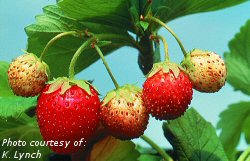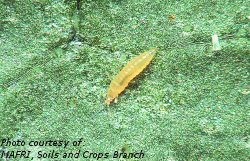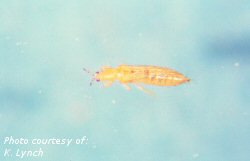Thrips (Frankliniella Tritici; And Possibly Other Species)

Fruit with typical bronzing

Severely bronzed fruit with cracking, also necrosis of bracts

Second instar nymph of western flower thrip

Adult thrip (Frankliniella tritici)
Host Plants And Distribution
Thrips are primarily a pest in strawberries, although they have been known to attack raspberries and blackberries. They have been relatively minor pests in western Canada until recently. Damage caused by thrips has been reported from Manitoba, Alberta, Ontario and New Brunswick. They are known to attack strawberries in the central and northeastern U.S. and are a serious strawberry pest in Australia.
Biology
Thrips are tiny (1.3 mm in length) cigar-shaped insects. Adults are brown to yellow in colour, have fringed wings and are weak fliers. Adult females lay eggs directly in plant tissues. Immature thrips (nymphs) are wingless, fast moving and yellow in colour. Adults and nymphs prefer to hide in protected places. Thrips are not known to overwinter in large numbers in Canada. They are suspected to migrate in each year on southerly wind currents. Within a growing season they can complete several generations in a short period of time.
Symptoms And Damage
Thrips are a common sight on strawberries, although significant injury from them is unusual. Thrips damage is caused by the rasping-sucking action of their mouthparts. They begin feeding on seeds immediately after the buds open. The rasped areas of the berry under the cap tend to crack and split as the fruit grows. Early damage to berries results in fruit being scarred and discoloured just beneath the calyx. Mature berries tend to be seedy, smaller, cracked, and brownish in colour and have a rubbery consistency. Bronzing, as the damage is called, is caused by feeding damage just under the calyx when the fruit is from 10-20 mm in diameter. Heavy infestations can almost completely destroy the buds and flowers before the fruits have had a chance to develop. In Australia, thrips have caused damage similar to that caused by tarnished plant bug. This cat-facing has not been observed in North America and the species that causes the damage in Australia does not occur in North America.
Scouting Techniques
Monitoring for thrips is carried out as follows. Collect 10 flower buds in a sealable plastic bag. Place the bag on the hood of the car so that the heat will kill the thrips, making them easier to count. Repeat the process in various locations to get an indication of the population of thrips across the field. Count the number of thrips per flower to determine whether the economic threshold has been reached. Sticky traps may also be used to monitor this insect.
Economic Thresholds
Treatment for thrips is not recommended unless populations exceed 10 per blossom. When berries reach a size of 10 mm, 50 randomly selected fruit should be examined. If, on average, there are greater than 0.5 thrips per fruit, control measures are recommended. Although thrips can cause economic damage in strawberries, the decision to control them should be based on the economic threshold as flower thrips also feed on spider mite eggs.
